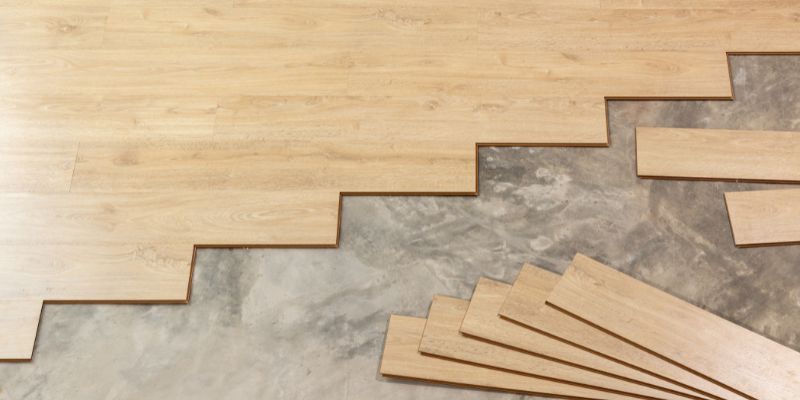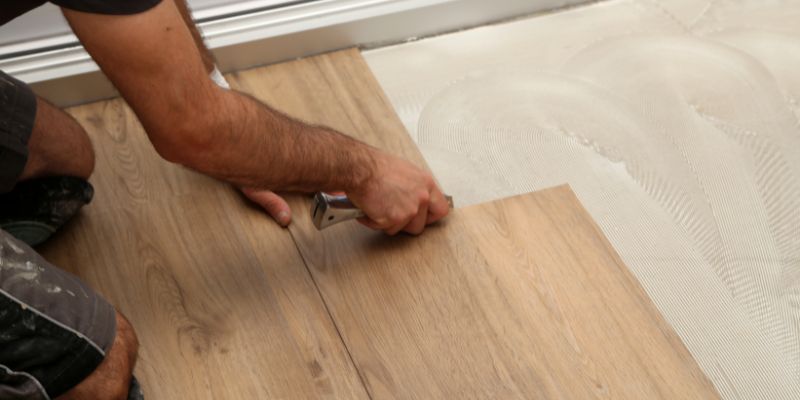If you don’t stagger vinyl flooring, it can result in an unattractive and unstable installation. Staggering vinyl flooring ensures that the end joints are not aligned, which helps maintain the strength and integrity of the floor, preventing gaps and buckling.
A properly staggered vinyl floor not only enhances its aesthetics but also improves its durability and lifespan. Staggering involves installing planks in a staggered pattern, so each row begins with a partial plank, resulting in a more secure and visually appealing flooring.
By avoiding a repetitive pattern, the floor maintains better stability and resistance to wear and tear. Consequently, it preserves its structural integrity and keeps your flooring looking its best for years to come.
Importance Of Staggering Vinyl Flooring
When it comes to installing vinyl flooring, there are certain techniques and best practices that ensure a successful and visually appealing installation. One crucial aspect of vinyl flooring installation is staggering. Staggering refers to the pattern in which the vinyl planks are laid, alternating the starting point of each row to prevent a repeating pattern. Ignoring this important step can lead to various issues and affect the overall appearance and structural stability of your vinyl flooring. In this article, we will discuss the importance of staggering vinyl flooring and the consequences of not doing so.
Prevents Visible Repeating Patterns
Vinyl flooring often comes in planks or tiles with designs, textures, or patterns. When these planks are installed without staggering, a visible repeating pattern can emerge, which can look unattractive and artificial. This repeating pattern creates a monotonous visual effect that undermines the authenticity and natural appearance of the floor.
Staggering vinyl flooring is crucial to avoid such visual repetition. By starting each row at a staggered point, the planks create a more random and natural-looking pattern. This not only enhances the aesthetic appeal of your flooring but also gives the impression of real wood or tile, depending on the vinyl design you chose. Moreover, staggering eliminates the possibility of an obvious seam running across the floor, giving it a seamless and professional finish.

Enhances Structural Stability
In addition to improving the visual appeal, staggering vinyl flooring also plays a significant role in maintaining the structural stability of the installation. Vinyl planks are not rigid and can slightly expand or contract with changes in temperature and humidity. If the planks are not staggered, this movement can become concentrated in one direction, leading to excessive stress on the flooring joints.
To ensure each plank has enough room to expand or contract without causing issues, staggering is essential. This arrangement distributes the forces exerted due to temperature or moisture changes more evenly across the floor. It minimizes the chances of buckling, warping, or gaps appearing between the planks. By properly staggering the vinyl flooring, you can guarantee its longevity and durability, as it can withstand the natural movements caused by environmental factors.
Therefore, not only does staggering vinyl flooring improve its visual appeal, but it also ensures its structural stability over time. Whether you’re installing vinyl flooring in a residential or commercial setting, following the proper staggering technique is vital for a successful and long-lasting installation.
Consequences Of Not Staggering Vinyl Flooring
When installing vinyl flooring, it is essential to properly stagger the planks or tiles. Staggering involves offsetting each row to create a visually appealing and structurally sound floor. Unfortunately, failing to stagger vinyl flooring can lead to several unfortunate consequences that may negatively impact the appearance and longevity of your new floor. In this article, we will explore the potential consequences of not staggering vinyl flooring and why it is crucial to follow this installation technique.
Visible Seam Lines
If you choose not to stagger vinyl flooring, one of the most noticeable consequences is the appearance of visible seam lines. Vinyl planks or tiles are typically manufactured with patterns and textures that mimic the look of natural wood or stone. These patterns are designed to enhance the overall aesthetic of the floor. However, when the planks or tiles are installed without staggering, the seam lines between each piece become more prominent and disrupt the visual flow of the floor.
By staggering the vinyl flooring, you create a randomized arrangement of planks or tiles, minimizing the visibility of seam lines. This helps create a more cohesive and seamless appearance, giving the impression of a larger and more continuous floor space.
Potential Structural Damage
Another consequence of not staggering vinyl flooring is the potential for structural damage over time. When planks or tiles are installed in a straight-line pattern without staggered joints, the seams become more vulnerable to stress and movement.
Over time, foot traffic, temperature changes, and moisture exposure can cause the vinyl planks or tiles to expand, contract, or shift. Without the staggered joints to distribute the stress and movement, the seams may become more prone to cracking, buckling, or separation. This can lead to an uneven and unstable floor surface, posing safety hazards and requiring costly repairs.
Factors Affecting Staggering
Staggering is crucial when installing vinyl flooring as it helps to minimize visible seams and ensure stability. If you fail to stagger the planks correctly, it can result in an unattractive appearance and possible issues with the overall durability and longevity of the floor.
When it comes to installing vinyl flooring, properly staggering the planks is crucial for a seamless and attractive finish. Staggering refers to the pattern in which the planks are laid, ensuring that the end joints are not directly aligned from row to row. Not staggering vinyl flooring can create a visually unappealing look, compromising the overall aesthetic of the room. Additionally, it can also affect the performance and durability of the floor. Various factors come into play when determining how to stagger vinyl flooring, including the size and shape of the room, the width and length of the planks, and the installation method. Let’s explore each of these factors in more detail.
Size And Shape Of The Room
The size and shape of the room play a significant role in determining the staggering pattern for vinyl flooring. A wide, open space allows for more flexibility in the stagger, as there is ample room to create a visually pleasing pattern. On the other hand, smaller or irregularly shaped rooms may pose challenges in achieving an ideal stagger, especially if the area is not a perfect rectangle or square.
Width And Length Of Vinyl Planks
The width and length of the vinyl planks also influence how they should be staggered. If the planks are wider, staggering becomes more crucial to prevent the joints from lining up and creating noticeable seams. Long planks, on the other hand, may require additional stagger to maintain a balanced and consistent look throughout the installation. Consider the dimensions of your vinyl planks when determining the appropriate staggering pattern.
Installation Method
The installation method employed can also impact how vinyl flooring should be staggered. There are different installation methods available, including glue-down, click-lock, and loose lay. Each method may have specific requirements for staggering that need to be followed for a successful installation. Therefore, it is essential to refer to the manufacturer’s guidelines and recommendations for the particular installation method being used.

Tips For Properly Staggering Vinyl Flooring
Properly staggering vinyl flooring is crucial to avoid problems down the line. Failure to do so can result in an unappealing look, weak joints, and potential damage to the flooring. It’s important to follow these tips to ensure a professional and long-lasting installation.
Use Manufacturer’s Instructions
One of the most important tips for properly staggering vinyl flooring is to follow the manufacturer’s instructions. Each brand and type of vinyl flooring may have specific requirements for the installation process, including the recommended stagger pattern. By adhering to the manufacturer’s instructions, you can ensure that the flooring is installed correctly and will provide long-lasting durability.
Most vinyl flooring manufacturers provide detailed installation guidelines and recommendations for staggering. These instructions may indicate the specific dimensions for each plank, the recommended overlap or gap between planks, and the proper direction to stagger the seams. Make sure to carefully read and understand these instructions before starting the installation process.
Following the manufacturer’s instructions not only ensures proper installation but also maintains the integrity of any warranties associated with the vinyl flooring. Failure to adhere to the recommended stagger pattern could void any warranty coverage, leaving you responsible for any future repairs or replacements.
Consider Room Layout And Traffic Patterns
Another important factor to consider when staggering vinyl flooring is the room layout and traffic patterns. Different rooms may have unique layout configurations that require specific stagger patterns to achieve a balanced and visually appealing look.
For instance, in rectangular-shaped rooms, it is common to start the first row of vinyl planks along one of the longer walls, staggering the end joints across subsequent rows. This arrangement creates a more symmetrical and aesthetically pleasing appearance. On the other hand, irregularly shaped rooms may require a different staggering approach to accommodate their specific layout.
In addition to the room layout, it’s also crucial to consider the traffic patterns within the space. Areas with heavy foot traffic, such as entrances or hallways, may require a slightly different staggering pattern to minimize wear and tear on the seams. By strategically staggering the vinyl planks, you can distribute the load and reduce the risk of premature damage.
By taking into account the room layout and traffic patterns, you can ensure that the staggered vinyl flooring not only looks visually pleasing but also performs optimally under everyday use.
Conclusion
Ultimately, not staggering vinyl flooring can result in several negative consequences. It can lead to an unappealing and uneven appearance, as well as potential damage due to increased pressure on certain areas. Additionally, without staggered vinyl flooring, the risk of buckling and expansion issues also increases.
It is crucial to follow proper installation techniques to ensure a long-lasting and visually pleasing vinyl flooring. Remember, taking the time to stagger the planks will pay off in the long run.



One thought on “What Happens If You Don’t Stagger Vinyl Flooring: Revealing the Consequences”